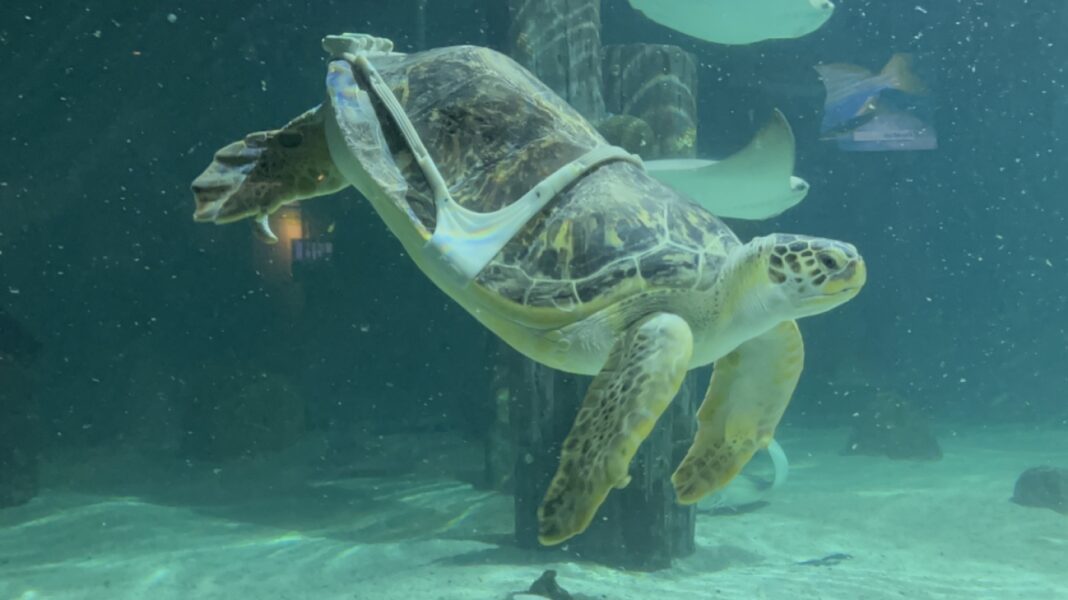
Charlotte, a male green sea turtle, wears a 3D-printed harness to help him overcome “bubble butt syndrome” — a condition caused by a boat strike. Charlotte lives at the Mystic Aquarium in Connecticut.
Formlabs
hide caption
toggle caption
Formlabs
Sea turtles can survive being struck by a boat propeller — but as they heal from the trauma, their shells often change shape, bulging from air building up within their bodies. That throws the animals’ buoyancy off-kilter when they swim, leading to “positive buoyancy syndrome,” a condition known more colorfully as “bubble butt syndrome.”
Bubble butt can leave turtles struggling to swim normally — or unable to submerge at all. The condition is so debilitating, rescued turtles that suffer from it are routinely deemed unable to be released back into the ocean.
But a “bubble butt” male turtle named Charlotte is now swimming more smoothly at the Mystic Aquarium in Connecticut, thanks to a harness built by a 3D printer. It took years of work, but in a recent fitting, the harness snapped quickly into place, and Charlotte found himself swimming more freely.
“I mean, the staff was super pumped,” Alex Pestana, a sales engineer at 3D printing company Formlabs, tells NPR. More importantly, he adds, “Charlotte loved it.”
The goal now, he says, is to develop a template for harnesses that could help other turtles.
Charlotte was taken in for care in Jekyll Island, Ga., in 2008. He then passed from the Georgia Sea Turtle Center to the Mystic Aquarium. Along the way, he was identified as a male.
Bubble Butt: The origin story
A male green sea turtle was given the name Bubble Butt at The Turtle Hospital in the Florida Keys shortly after he arrived there in 1989. His dramatically deformed shell constantly pushed his rear end toward the water’s surface.
“At the time, experts could not explain why he was unable to dive and he became the first documented case of a turtle suffering from ‘Bubble Butt Syndrome,’ ” The Turtle Hospital says on its website.
“Unfortunately, it’s a very common condition in wild sea turtles because their spinal cord is connected to the top of their shells,” Dr. Molly Martony, senior veterinarian at the Mystic Aquarium, told NPR’s Here & Now. If a boat’s propeller strikes the shell, she added, it can damage the spinal cord and interfere with the gastrointestinal tract’s function.
“Really what you’re seeing is, the animal’s floating from the gas that’s in the intestines,” Bette Zirkelbach, the Turtle Hospital’s manager, tells NPR. “We believe it’s a neurological issue that causes ileus of the intestines, which means basically that it just cannot push all the gas out. They can eat and they defecate, but if you look at the shape of the shell and then do a radiograph, you’re going to see that gas and the intestines is filling up that space.”
The buoyancy makes it hard for the turtles to reach their food sources on the ocean floor, Zirkelbach says. It also makes them more prone to further boat strikes and predator attacks.
To counteract Bubble Butt’s wayward flotation, the Florida facility’s staff affixed 2 1/2 pounds of lead to his shell (a negligible addition for a reptile weighing more than 100 pounds). That helped the turtle live a more normal life. But gluing weights onto the shell isn’t a permanent solution — they move as the animals grow and will come off as a sea turtle sheds scutes — the thick plates on its keratin shell, the University of Minnesota notes.
Bubble Butt died in 2022. But by then, efforts were under way to use 3D printing to help turtles like him. With harnesses like the one Charlotte now has, weights can be added incrementally, to help the animals adjust.

Charlotte is lowered into the water at Mystic Aquarium to test out a version of the harness.
Courtesy Formlabs
hide caption
toggle caption
Courtesy Formlabs
Charlotte’s harness could be a prototype
The drive to give Charlotte a harness took around five years. Formlabs worked on the project along with another 3D printing firm, Adia, and New Balance, the shoe company.
“New Balance provided a lot of software expertise and design work,” Pestana says.
A 3D scan of Charlotte’s shell gave engineers an early sense of the shape they would need to create. But it was harder to land on a design and material that would help the sea turtle.
“The harness is basically made up of five or six pieces that will sort of tie in, to make sure the fit is kind of equal on all sides,” Pestana says. One promising prototype broke when workers dropped it, highlighting the need for a material that was stiff but not too brittle, while also being comfortable for Charlotte.
After trial and error, the team found that adding carbon fiber to plastic powder gave the harness the durability and flexibility they were seeking. Since the news of their success emerged, other aquariums have asked for help with their bubble butt turtles. Pestana says the team is looking for volunteers with CAD experience, to translate Charlotte’s bespoke harness into a design that can adjust to different measurements.
Seeing more boat strikes in Florida
The Turtle Hospital currently has around 15 turtles that are non-releasable due to bubble butt syndrome, according to Zirkelbach. The facility uses them to donate blood to save other turtles — and to help educate the public, in hopes of lowering what she says is a rising number of boat strikes.
“It’s important to have a spotter on the front of your boat, somebody in polarized sunglasses that can see in the water,” Zirkelbach says.
She also says boaters should obey speed restrictions, many of which apply in shallower areas.
“In shallow water,” she says, animals such as sea turtles, dolphins and manatees “really have nowhere to get away from the boats — they can’t dive down.”




